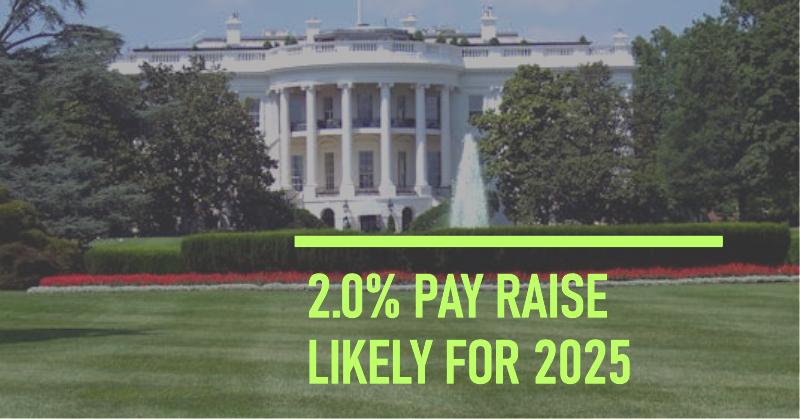President Biden proposed 2% federal pay raise for the 2025 budget in March. Not likely to change unless there’s action from congress to adjust the 2025 federal pay raise for civilian workers.
White House Likely Sticking with 2% for the 2025 Federal Pay Raise
Back in March, the Biden administration put forth the 2025 budget proposal which includes a 2.0% pay raise for federal employees. This proposal is well below the 7.4% figure suggested by the FAIR act, a bill in Congress introduced in February. Understanding the intricacies of this proposed salary increase, the underlying rationale, and its potential impacts on the federal budget are crucial for all stakeholders including feds and the public.
What is the proposed 2025 federal employee raise?
Details of President Biden’s Fiscal 2025 budget request
President Biden’s 2025 suggested budget included a 2% raise for civilian federal employees. This raise is a continuation of the administration’s commitment to maintaining competitive compensation for federal employees – but still well below the previous 2 years which saw 5.2% (2024) and 4.6% (2023). The 2.0% average increase is part of a broader strategy outlined in the FY 2025 budget, which aims to address various aspects of federal compensation, including base pay and locality pay adjustments.
How does the proposed raise compare to previous years?
The 2% raise for 2025 may seem conservative in comparison to 2024 and 2023’s raises; however, it is designed to be sustainable within the larger framework of federal budget constraints and economic projections.
Knowledge is Confidence!
What is the expected average pay increase for federal workers in 2025?
The expected average pay increase for federal workers in 2025 is projected to be around 2%, a figure that balances the need for competitive wages with fiscal responsibility. This increase, while not as substantial as in previous years, indicates a continued effort to provide adequate compensation increases and maintain pay parity with the private sector. Note that the 2.0% is an average, however. When locality pay is factored in, some feds will see a pay increase slightly larger than the flat 2.0% due to high cost-of-living in their area and others may see a raise that is a bit less, likely around 1.7%.
Why is there a 2025 pay raise for federal employees?
Understanding the rationale behind the federal pay raise

The key rationale behind the annual raise for feds comes from the need to attract and retain skilled professionals within the federal workforce. With this annual raise, the administration aims to address issues of pay parity between federal and private sector employees – although the gap between the sectors has been widening for the past few decades. The raise also seeks to acknowledge the hard work and dedication of federal employees who have played an essential role in maintaining government operations amid various challenges.
The role of the Federal Salary Council in this decision
The Federal Salary Council plays a crucial role indetermining pay raises. For the 2025 White House budget recommendations, thecouncil’s members conducted comprehensive reviews and analyses to recommendappropriate pay adjustments. Their recommendations aim not only to ensure faircompensation but also to strategically address disparities between federal payand private sector pay, thereby influencing the administration’s decision topropose the 2% raise, which the council announced in the summer of 2023.
How does the 2025 raise aim to address pay parity?
The 2025 raise aims to address pay parity by narrowing the gap between compensation for federal workers and their counterparts in the private sector. Over the years, there has been a persistent disparity in pay levels that has affected the federal workforce’s competitiveness. By implementing a 2% pay increase, the administration has slightly narrowed the gap between federal salaries and those found outside of the public sector.
How does the 2025 pay raise affect the federal budget?
The impact on the fiscal year 2025 federal budget
The proposed 2% pay raise will have a significant impact on the federal budget. While the pay increase is necessary for maintaining a motivated workforce, it also translates into higher payroll expenses for federal agencies. These increased costs need to be carefully balanced against other budgetary priorities, including infrastructure, defense, and social programs. As part of the annual budgetary suggestions from the White House, these considerations are meticulously evaluated to ensure fiscal responsibility.
Insights from the House Appropriations Committee
The House Appropriations Committee has provided insights into the potential budgetary implications of the 2025 raise. The committee’s assessments usually consider the overall economic environment, projected tax revenues, and other fiscal policies. They weigh the benefits of employee retention and morale against the necessity to control federal expenditure, providing a nuanced perspective on the practical implementation of the pay raise within the overall budget request.
Analysis of the OPM’s stance
The Office of Personnel Management (OPM) supports the 2.0% raise, emphasizing its importance for sustaining an efficient and dynamic federal workforce. The OPM’s stance is informed by detailed studies and data analysis that highlight the need for regular pay adjustments to cope with rising living costs and the competitive private sector environment. Take what you can get, I guess. The endorsement underscores the necessity of the proposed 2% increase, aligning it with broader strategic goals for workforce management and policy development.
What challenges does the 2025 Pay Raise face?
Legislative hurdles and potential opposition
The raise next year is likely to face few legislative hurdles and potential opposition, although there will be some from lawmakers concerned about budget deficits and fiscal prudence. While the proposed pay increase is designed with numerous benefits in mind, such as improved federal employee satisfaction and retention, it must either pass through a legislative process (such as the annual fiscal budgetary measures) or, and this has been the case over the past 10 years or so, it is enacted via an executive order signed by the President. This usually happens around the holiday season.
White House likely to Confirm 2% Raise
Without any action in August, it is expected that Biden will confirm his intention to implement a 2.0% average pay raise in federal employee pay. The decision will not be finalized, however, until an executive order (or a bill approved by Congress) is officially signed by President Biden.
When will next year’s pay raise take effect?
Timeline for pay plan implementation
The implementation timeline for next year’s pay plan is expected to follow the fiscal calendar, with the raise taking effect at the beginning of the fiscal year (October). Federal employees can anticipate seeing the pay increase reflected in their paychecks early in the calendar year (January). Detailed implementation schedules will be outlined by OPM and communicated to all federal agencies to ensure a smooth transition.
What federal employees need to know about the raise in 2025
Federal employees need to stay informed about the specifics of the 2025 raise, including how it affects their base pay and potential locality pay adjustments. Ongoing communications from the Office of Personnel Management and their respective agencies will provide detailed information and guidance. Understanding the components of the pay increase and its implications on overall compensation packages will help employees manage their expectations and financial planning effectively.
Reach Out to Us!
If you have additional federal benefit questions, contact our team of CERTIFIED FINANCIAL PLANNER™ (CFP®) and Chartered Federal Employee Benefits Consultants (ChFEBC℠). At PlanWell, we are federal employee financial advisors with a focus on retirement planning. Learn more about our process designed for the career fed.
Preparing for federal retirement? Check out our scheduled federal retirement workshops. Sign up for our no-cost federal retirement webinars by visiting our workshop registration page. Make sure to plan ahead and reserve your seat for our FERS webinar, held every three weeks. Want to have PlanWell host a federal retirement seminar for your agency? Reach out, and we’ll collaborate with HR to arrange an on-site FERS seminar.
Want to fast-track your federal retirement plan? Skip the FERS webinar and start a one-on-one conversation with a ChFEBC today. You can schedule a one-on-one meeting with our team.









